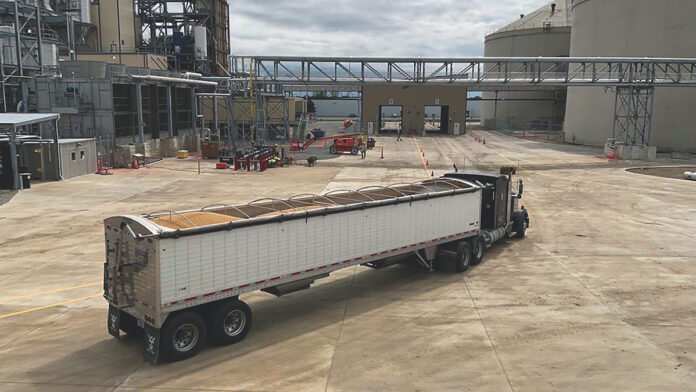
SALEM, Ohio — Ohio’s soybean processing capacity is growing, riding a wave of interest in renewable fuels.
The state’s crush capacity could grow as much as 35% in the next few years. Global food processing giant Cargill recently brought its expanded crush plant in Sidney online, nearly doubling the capacity of the old plant, and French company Louis Dreyfus announced plans to build a new crush plant in Upper Sandusky.
That’s good news for Ohio farmers, who in the short term could see better prices at local elevators that will be competing for feedstock for their customers, said Steve Reinhard, vice chair of the United Soybean Board.
In the long term, the addition of domestic markets for the commodity could add resilience to an industry that relies heavily on exports.
“When we talk about adding value to soybeans, whatever we can do locally is going to be more beneficial,” said Reinhard, who is also a farmer in Bucyrus, Ohio.
Growing and upgrading
Cargill held a tour Nov. 2, attended by Ohio Lt. Gov. Jon Husted, to celebrate the opening of its expanded and updated soybean processing plant in Sidney, Ohio.
The new facility, which came online in September, can process 60 million bushels a year. The new plant was built adjacent to the existing plant, built in 1978, which will be decommissioned.
Justin Rismiller, a Cargill spokesman, told Farm and Dairy that the decision to upgrade and expand soy processing capacity in Ohio was part of the company’s overall strategy to modernize and expand its U.S. oilseed plants.
“When we looked around at our fleet, Sidney has been a really strong market for us for a really long time,” Rismiller said.
The plant draws from hundreds of farmers and elevators in Ohio and eastern Indiana, Rismiller said. They produce soybean meal for livestock feed, and soybean oil for food service and retail customers around the country. The new plant, plans for which were announced in 2019, employs 275 people and added about a dozen new full-time positions with the expansion.
Building new
The Louis Dreyfus Company announced plans last month to build a new Ohio soybean crush facility in Upper Sandusky, in Wyandot County, that will have an annual crush capacity of more than 55 million bushels.
The French merchant firm and agricultural processor is investing $500 million in the facility, construction on which is expected to begin early next year. Dreyfus’ chief executive officer J.P. Nauseef said in a statement the plant will bring more than 100 new jobs to the state.
The company said the plant will also have vegetable oil refining and lecithin production and packaging capabilities. The proposed plant was praised by commodity groups and elected officials alike for its investment in the region’s economy.
Domestic growth
Crushing is a key part of processing soybeans into two marketable products — soybean meal and soybean oil. The meal is largely used to make animal feeds, but it can also be used to produce soy milk and tofu. Soybean oil is used in foods like salad dressings and mayonnaise, as well as in industrial products such as biofuels and plastics.
Until recently, soybean meal has been the main market, with its high-protein content being highly valued as an ingredient in livestock feeds, but now, the oil could become the more valuable part of the bean, Reinhard said.
Soybeans have also traditionally relied on strong export markets. Nearly 60% of U.S. soy products, which include whole soybeans, meal and oil, are exported each year, according to the U.S. Soybean Export Council. However, the push toward low-carbon fuel sources is growing the need at home for soybean oil, which is a major component in biodiesel and sustainable aviation fuel.
“With the biofuels market and sustainable aviation fuels, and with sustainability in general, a lot of consumers are demanding more products made from green resources,” Reinhard said. “Soybeans offer that alternative.”
There are around 60 soybean crush plants currently in the U.S., with more than two dozen plant expansions and new builds having been announced in the past several years. The Ohio Soybean Council said crush capacity is expected to grow nationwide by as much as 30% over the next three years.
There are four crush facilities in Ohio. In addition to Cargill’s plant in Sidney, Bunge has plants in Bellevue and Delphos and ADM has a crush plant in Fostoria. There were 134.8 million bushels of soybeans crushed in Ohio during the market year 2021-22, according to Ohio Soybean Council data.
The addition of the Cargill plant increased the state’s soybean crush capacity by nearly 15%. If the Louis Dreyfus plant comes to fruition as proposed, it will bring Ohio’s crush capacity to 209.8 million bushels, a 35% increase.
There is some concern if these new facilities will have enough local soybeans to feed the additional capacity. Ohio’s average soybean production over the last five years was 264 million bushels. Reinhard believes yields will come up to meet the increased crush capacity. In fact, the increased capacity should yield better prices for farmers, he said.
“Having this additional crush capacity will create competition,” Reinhard said. “We’ll be able to move through those piles faster,” especially at harvest time when prices usually drop because of the influx of product coming in straight from the fields.











